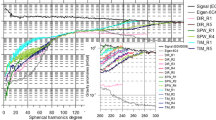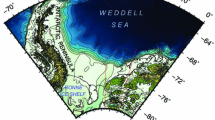Abstract
Gravity field and steady-state Ocean Circulation Explorer (GOCE) is the first satellite mission that observes gravity gradients from the space, to be primarily used for the determination of high precision global gravity field models. However, the GOCE gradients, having a dense data distribution, may potentially provide better predictions of the regional gravity field than those obtained using a spherical harmonic Earth Geopotential Model (EGM). This is investigated in Auvergne test area using Least Squares Collocation (LSC) with GOCE vertical gravity gradient anomalies (Tzz), removing the long wavelength part from EGM2008 and the short wavelength part by residual terrain modelling (RTM). The results show that terrain effects on the vertical gravity gradient are significant at satellite altitude, reaching a level of 0.11 Eötvös unit (E.U.) in the mountainous areas. Removing the RTM effects from GOCE Tzz leads to significant improvements on the LSC predictions of surface gravity anomalies and quasigeoid heights. Comparison with ground truth data shows that using LSC surface free air gravity anomalies and quasi-geoid heights are recovered from GOCE Tzz with standard deviations of 11 mGal and 18 cm, which is better than those obtained by using GOCE EGMs, demonstrating that information beyond the maximal degree of the GOCE EGMs is present. Investigation of using covariance functions created separately from GOCE Tzz and terrestrial free air gravity anomalies, suggests that both covariance functions give almost identical predictions. However, using covariance function obtained from GOCE Tzz has the effect that the predicted formal average error estimates are considerably larger than the standard deviations of predicted minus observed gravity anomalies. Therefore, GOCE Tzz should be used with caution to determine the covariance functions in areas where surface gravity anomalies are not available, if error estimates are needed.
Similar content being viewed by others
References
Amante C. and Eakins B.W., 2009. ETOPO1 1 Arc-Minute Global Relief Model: Procedures, Data Sources and Analysis. NOAA Technical Memorandum NESDIS NGDC-24, 19 pp., NOAA, Boulder, Colorado.
Arabelos D. and Tscherning C.C., 1990. Simulation of regional gravity field recovery from satellite gravity gradiometer data using collocation and FFT. Bull. Geod., 64, 363–382.
Arabelos D. and Tscherning C.C., 1995. Regional recovery of the gravity field from satellite gradiometer and gravity vector data using collocation. J. Geophys. Res., 100(B11), 22009–22015.
Arabelos D. and Tscherning C.C., 2010. A comparison of recent Earth gravitational models with emphasis on their contribution in refining the gravity and geoid at continental or regional scale. J. Geodesy, 84, 643–660, DOI: 10.1007/s00190-010-0397-z.
Bouman J., 2007. Alternative Method for Rotation to TRF. GO-TN-HPF-GS-0193. Issue 1.0. (http://earth.esa.int/pub/ESA_DOC/GOCE/GO-TN-HPF-GS-0193_1.0-FrameTransformation.pdf).
Drinkwater M.R., Floberghagen R., Haagmans R., Muzi D. and Popescu A., 2003. GOCE: ESA’s first Earth explorer core mission. In: Beutler G., Drinkwater M.R., Rummel R. and von Steiger R. (Eds.), Earth Gravity Field from Space — from Sensors to Earth Science. Space Science Series of ISSI, 17, 419–432, Kluwer, Dordrecht, The Netherlands.
Duquenne H., 2007. A data set to test geoid computation methods. Proceedings of the 1st International Symposium of the International Gravity Field Service (IGFS), Istanbul, Turkey. Harita Dergisi, Special Issue 18, 61–65.
Forsberg R., 1984. A Study of Terrain Reductions, Density Anomalies and Geophysical Inversion Methods in Gravity Field Modeling. Report No. 355. Department of Geodetic Science and Surveying, The Ohio State University, Colombus, OH.
Forsberg R. and Tscherning C.C., 1981. The use of height data in gravity field approximation by collocation. J. Geophys. Res., 86(B9), 7843–7854.
Forsberg R. and Tscherning C.C., 2008. An overview manual for the GRAVSOFT Geodetic Gravity Field Modelling Programs. 2nd Edition. Contract Report for JUPEM (http://cct.gfy.ku.ak/publ_cct/cct1936.pdf).
Gruber T., Rummel R., Abrikosov O. and van Hees R., 2010. GOCE Level 2 Product Data Handbook. GO-MA-HPF-GS-0110, Issue 4.2. (http://earth.esa.int/pub/ESA_DOC/GOCE/GOMA-HPF-GS-0110_4.2-ProductDataHandbook.pdf).
Knudsen P., 1987. Estimation and Modelling of the Local Empirical Covariance Function using gravity and satellite altimeter data. Bull. Geod., 61, 145–160.
Lemoine F.G., Kenyon S.C., Factor J.K., Trimmer R.G., Pavlis N.K., Chinn D.S., Cox C.M., Klosko S.M., Luthcke S.B., Torrence M.H., Wang Y.M., Williamson R.G., Pavlis E.C., Rapp R.H. and Olson T.R., 1998. The Development of the Joint NASA GSFC and the National Imagery and Mapping Agency (NIMA) Geopotential Model EGM96. NASA Technical Report TP-1998-206861, National Aeronautics and Space Administration, Goddard Space Flight Center, Greenbelt, Maryland, USA.
Moritz H., 1980. Advanced Physical Geodesy, Herbert Wichman, Karlsruhe, Germany.
Pail R., Bruinsma S., Migliaccio F., Foerste C., Goiginger H., Schuh W.-D., Hoeck E., Reguzzoni M., Brockmann J.M., Abrikosov O., Veicherts M., Fecher T., Mayrhofer R., Krasbutter I., Sansó F. and Tscherning C.C., 2011. First GOCE gravity field models derived by three different approaches. J. Geodesy, 85, 819–843.
Pavlis N.K., Holmes S.A., Kenyon S.C. and Factor J.K., 2008. An Earth Gravitational Model to Degree 2160: EGM2008. (http://www.massentransporte.de/fileadmin/2kolloquium_muc/2008-10-08/Bosch/EGM2008.pdf).
Sansó F., Venuti G. and Tscherning C.C., 2000. A theorem of insensivity of the collocation solution to variations of the metric in the interpolation space. In: Schwarz K.P. (Ed.), Geodesy beyond 2000. International Association of Geodesy Symposia 121, 233–240, Springer-Verlag., Heidelberg, Germany.
Tscherning C.C., 1982. Geoid determination for the Nordic countries using collocation. Proceedings of the General Meeting of the International Association of Geodesy, Tokyo, May 7–15, 1982. J. Geodetic Soc. Japan, Special issue, 472–483, (http://www.gfy.ku.dk/~cct/publ_cct/cct83.pdf)
Tscherning C.C., 2001. Geoid determination after the first satellite gravity missions. Festschrift Univ. Prof. em. Dr.-Ing. Wolfgang Torge zum 70. Geburtstag. Wiss. Arb. Fachr. Verm. Univ. Hannover, Nr. 241, 11–14 (http://www.gfy.ku.dk/~cct/torge02.htm).
Tscherning C.C. and Arabelos, D. 2011. Gravity anomaly and gradient recovery from GOCE gradient data using LSC and comparisons with known ground data. Proceedings 4th International GOCE User Workshop, 31 March–April 1, 2011, ESA Publications Division, Nordwijk, The Netherlands, SP-696.
Tscherning C.C. and Rapp R.H., 1974. Closed Covariance Expressions for Gravity Anomalies, Geoid Undulations, and Deflections of the Vertical Implied by Anomaly Degree-Variance Models. Report No. 208, Department of Geodetic Science and Surveying, The Ohio State University, Colombus, OH.
Tscherning C.C., Forsberg R. and Vermeer M., 1990. Methods for Regional Gravity Field Modelling from SST and SGG Data. Reports of the Finnish Geodetic Institute, No. 90:2, Helsinki, Finland.
Author information
Authors and Affiliations
Corresponding author
Additional information
The manuscript solely reflects the personal views of the author and does not necessarily represent the views, positions, strategies or opinions of Turkish Armed Forces.
Rights and permissions
About this article
Cite this article
Yildiz, H. A study of regional gravity field recovery from GOCE vertical gravity gradient data in the Auvergne test area using collocation. Stud Geophys Geod 56, 171–184 (2012). https://doi.org/10.1007/s11200-011-9030-8
Received:
Revised:
Accepted:
Published:
Issue Date:
DOI: https://doi.org/10.1007/s11200-011-9030-8




